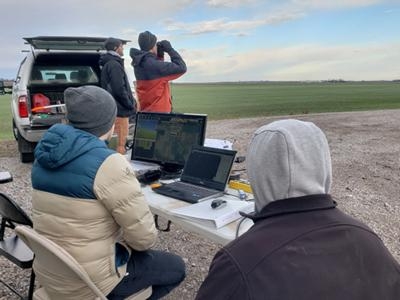First School To Be Granted An FAA Waiver To Perform The Flights
Students studying unmanned aircraft systems at the Kansas State University Polytechnic Campus are receiving a rare flight experience in some of their courses that is positioning them at the forefront of the drone industry.

Kansas State Polytechnic's UAS flight and operations degree option is the first in the nation to introduce flying beyond visual line of sight into college curriculum. The campus has been granted a waiver from the FAA to perform this type of unmanned operation. Currently restricted under federal regulations, only a handful of organizations in the United States have been authorized to fly UAS out of visual sight, with Kansas State Polytechnic receiving the first such waiver to a university by the FAA.
"It is a significant opportunity for our students to learn how to fly UAS beyond their visual line of sight because they are preparing their skills and knowledge for the future of the industry," said Kurt Carraway, UAS executive director of the Applied Aviation Research Center at Kansas State Polytechnic. "They also have a distinct advantage over their peers at other schools who don't have the authorization to do this yet, making them more marketable when they are ready to start their career."
This fall, two upper-division courses — Advanced Fixed Wing Operations and Flight and Field Operations — incorporated beyond visual line of sight into their flight labs. Considered a higher-risk operation, students' attention to detail and to safety were dramatically elevated.
"They first had to review the FAA waiver and understand how to fully comply with its specific requirements," said Travis Balthazor, flight operations manager of the Applied Aviation Research Center at Kansas State Polytechnic. "Students also learned new aspects of mission planning and how to best mitigate risk in the field, including using ADS-B software, which monitors other aircraft in their flight area."
In beyond visual line of sight, UAS are not flown manually, but instead by a ground control station linked to an autopilot system on the drone. In addition to training on these advanced technologies, students also had to learn about the behaviors of the entire unmanned system in a variety of scenarios in order to maintain control of the aircraft if any issues arise.
"In the long run, flying unmanned aircraft beyond visual line of sight is more practical and more efficient, so you're going to see operations like Amazon package delivery, mapping large quantities of farmland or inspecting several miles of power lines become more prevalent as regulations evolve," said Kurtis Liles, senior in UAS flight and operations, Wichita. "I'm proud to be a part of a program that already has the ability to perform this type of operation, and I'm excited to see how I can utilize my experiences in the industry after graduation."
The beyond visual line of sight waiver was first granted by the FAA to Kansas State Polytechnic's Applied Aviation Research Center this summer before being integrated into the UAS degree curriculum. Additionally, the campus has a waiver from the FAA to perform unmanned flight operations at night, which also has been added to several UAS courses.
(Image provided with Kansas State Polytechnic news release)
 Aero-News: Quote of the Day (04.28.25)
Aero-News: Quote of the Day (04.28.25) ANN's Daily Aero-Term (04.28.25): Decision Altitude (DA)
ANN's Daily Aero-Term (04.28.25): Decision Altitude (DA) ANN's Daily Aero-Linx (04.28.25)
ANN's Daily Aero-Linx (04.28.25) Airborne-Flight Training 04.24.25: GA Refocused, Seminole/Epic, WestJet v TFWP
Airborne-Flight Training 04.24.25: GA Refocused, Seminole/Epic, WestJet v TFWP Aero-News: Quote of the Day (04.29.25)
Aero-News: Quote of the Day (04.29.25)



